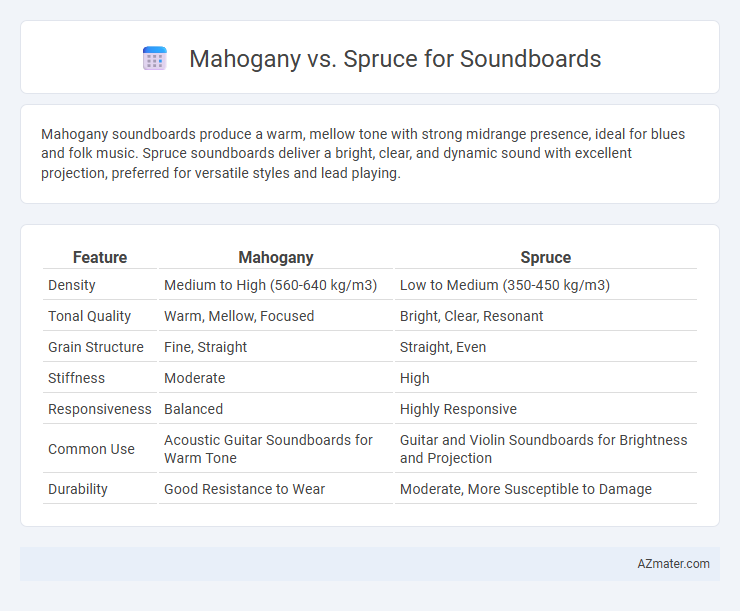Mahogany soundboards produce a warm, mellow tone with strong midrange presence, ideal for blues and folk music. Spruce soundboards deliver a bright, clear, and dynamic sound with excellent projection, preferred for versatile styles and lead playing.
Table of Comparison
| Feature | Mahogany | Spruce |
|---|---|---|
| Density | Medium to High (560-640 kg/m3) | Low to Medium (350-450 kg/m3) |
| Tonal Quality | Warm, Mellow, Focused | Bright, Clear, Resonant |
| Grain Structure | Fine, Straight | Straight, Even |
| Stiffness | Moderate | High |
| Responsiveness | Balanced | Highly Responsive |
| Common Use | Acoustic Guitar Soundboards for Warm Tone | Guitar and Violin Soundboards for Brightness and Projection |
| Durability | Good Resistance to Wear | Moderate, More Susceptible to Damage |
Introduction to Mahogany and Spruce Soundboards
Mahogany soundboards offer warm, rich tones with emphasized midrange frequencies, making them ideal for genres requiring smooth, mellow sound. Spruce soundboards provide bright, clear, and dynamic tonal qualities due to their high stiffness-to-weight ratio, enhancing projection and responsiveness. The choice between mahogany and spruce affects the guitar's resonance, sustain, and overall voice, crucial for tailoring sound to specific playing styles.
Wood Characteristics: Mahogany vs Spruce
Mahogany offers a warm, mellow tone with strong midrange emphasis due to its dense, fine-grained structure, ideal for rich, full-bodied soundboards. Spruce features a lighter, more resonant grain pattern that produces a bright, clear tone with excellent projection and dynamic range, favored for responsive soundboards. Both woods have distinct acoustic properties: mahogany's warmth and sustain contrast with spruce's clarity and sharp attack, influencing guitar sound character significantly.
Tone Comparison: Warmth, Brightness, and Balance
Mahogany soundboards produce a warm, rich tone with pronounced midrange frequencies, emphasizing depth and resonance, ideal for blues and folk styles. Spruce soundboards offer a brighter, clearer sound with enhanced treble response and dynamic range, suitable for genres requiring articulation and clarity like bluegrass or classical. The tonal balance of mahogany leans toward warmth and smoothness, while spruce provides a crisp, balanced spectrum with greater brightness and projection.
Projection and Volume: Which Wood Performs Better?
Spruce offers superior projection and volume for soundboards due to its lightweight and stiffness, allowing vibrations to transmit efficiently and produce a bright, clear tone. Mahogany provides a warmer, softer sound with less projection, emphasizing midrange frequencies but lacking the same dynamic loudness as spruce. For acoustic instruments seeking maximum volume and sound projection, spruce is generally the preferred material.
Sustain and Resonance Differences
Mahogany soundboards produce a warm, mellow tone characterized by strong midrange frequencies, offering a shorter sustain compared to spruce. Spruce soundboards are renowned for their bright, clear projection and longer sustain due to their lighter, stiffer grain structure enhancing resonance. The difference in wood density and stiffness directly influences the soundboard's ability to vibrate, with spruce maximizing resonance and mahogany emphasizing warmth and punch.
Durability and Stability Factors
Mahogany soundboards offer superior durability with a tight, interlocking grain structure that resists warping and cracking under varying humidity levels, making them ideal for longevity. Spruce soundboards, while slightly less stable, provide excellent resonance and responsiveness but require more careful humidity control to maintain structural integrity. Both woods contribute differently to tonal quality, but mahogany's robustness ensures consistent performance in diverse environmental conditions.
Aesthetic Appeal: Grain, Color, and Finish
Mahogany soundboards offer a warm, rich aesthetic characterized by a tight, interlocking grain pattern and deep reddish-brown color that darkens beautifully with age, making them a favorite for vintage-inspired finishes. Spruce soundboards showcase a lighter, pale cream to golden hue with a straight, uniform grain that highlights the wood's natural clarity and lends itself well to glossy, transparent finishes. The choice between mahogany and spruce soundboards significantly impacts visual appeal, with mahogany providing a classic, earthy look and spruce delivering a brighter, more vibrant aesthetic.
Application in Various Musical Genres
Mahogany soundboards produce a warm, woody tone with strong midrange presence, making them ideal for blues, folk, and jazz genres that emphasize rich, mellow sound. Spruce soundboards deliver bright, clear, and dynamic tones with excellent projection, favored in classical, bluegrass, and rock music for their versatility and responsiveness. Musicians choose mahogany for intimate, smooth sounds, while spruce suits genres requiring sharp articulation and volume.
Cost and Availability Considerations
Mahogany soundboards generally offer a warmer tone and are more affordable than spruce, making them a cost-effective choice for many guitar builders. Spruce, known for its bright and clear sound projection, tends to be pricier due to its higher demand and slower growth rate, impacting availability. Availability of mahogany is typically more consistent, while spruce can vary regionally, influencing purchase options and lead times for musicians and luthiers.
Choosing the Right Soundboard for Your Music Style
Mahogany soundboards produce a warm, focused tone with strong midrange presence, ideal for blues, folk, and fingerstyle players seeking balance and clarity. Spruce soundboards offer bright, dynamic projection with enhanced sustain, making them perfect for genres requiring clear articulation and varied tonal expression such as rock, pop, and bluegrass. Selecting between mahogany and spruce depends on your musical style's demand for warmth and midrange or brightness and projection.

Infographic: Mahogany vs Spruce for Soundboard
 azmater.com
azmater.com